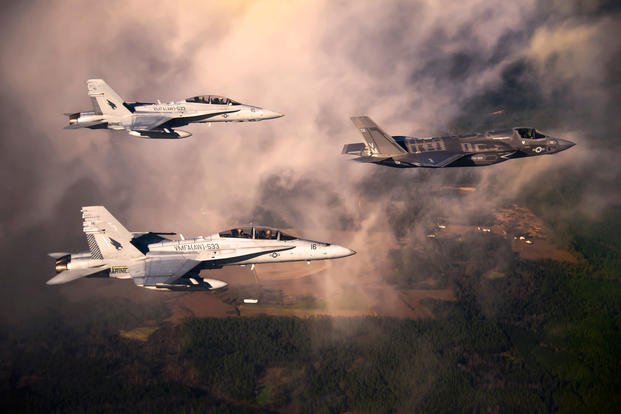The Marine Corps' aviation woes have posed the biggest challenge to the force's readiness, but the service's top general has a simple response to Defense Secretary Jim Mattis' call to improve aircraft mission-capable rates.
"Roger that," Commandant Gen. Robert Neller said during a Wednesday Defense Writers Group breakfast with reporters. "... I'm sure if we don't make it, we'll hear about it."
There's no single answer to improving overall aviation readiness, he said. Marine aviation has been plagued for years by steep budget cuts, high operational demands, parts shortages and less flying time for air crews.
That resulted in a "horrible year" for Marine aviation in 2017, Neller said, citing a July KC-130T crash that left 16 dead. Less than a month later, three Marines were killed when their MV-22B Osprey crashed near Australia, prompting a 24-hour operational pause in all flight operations.
Related content:
- Mattis Orders Supercharge in Fighter Jet Readiness
- New Marine Corps Pilots Flying 20 Percent Less Now Than a Decade Ago
- Spare Parts Shortage Grounds Many Marine Corps Aircraft
"We've got to do our part," the commandant said. "We've got to do a better job of managing our flight-hour program. … We've got to reset certain airplanes, and we've got to get some new airplanes."
Here's how the Marine Corps will meet Mattis' call to boost mission-capable rates of some of the service's most in-demand aircraft to more than 80 percent over the next year.
Ditching old aircraft.
The Corps is in the process of replacing several aging airframes and, when it does, it needs to get rid of the old models. Otherwise, they only put a strain on squadrons, Neller said.
"At some point, when you're getting new, you have to get rid of the old ones," he said. "[Or] you have a squadron that's designed to maintain 12 airplanes and they've got to maintain 16."
Harvesting old parts.
Before those jets and helicopters fly off to the boneyard, Neller said they should be checked for parts. Older CH-53s and F/A-18 Hornets, for example, could have parts that the Marine Corps can use on some of its upgraded models.
"We have to take advantage of the parts we can get off them," he said.
Pressing industry to do better.
Vendors also have a role to play. Their "quality has got to go up," Neller said. And if they're providing the services with new aircraft, they need to be prepared to stock the parts they'll need to maintain them.
It's not acceptable to have just one or two companies capable of manufacturing parts for the entire Defense Department's aviation fleet.
"We've got to have more depth," Neller said.
Printing its own parts.
One way the Marine Corps can work around parts shortages is by printing its own. The service is currently operating two metal printers, and it has plans to buy more, Neller said.
That will improve maintainers' access to the parts they need, he added.
In 2016, an MV-22 Osprey took flight using a 3-D printed part. The Army and Air Force have also used the technology to fix or even create a new aircraft.
-- Gina Harkins can be reached at gina.harkins@military.com. Follow her on Twitter at @ginaaharkins.













